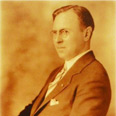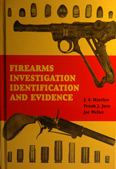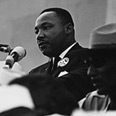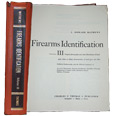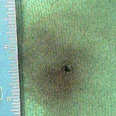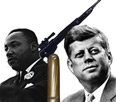Home | Glossary | Resources | Help | Contact Us | Course Map
Archival Notice
This is an archive page that is no longer being updated. It may contain outdated information and links may no longer function as originally intended.
1955-1958
1955
Calvin H. Goddard presented an address, "The Unexpected in Firearms Identification," at the American Academy of Forensic Sciences meeting in Los Angeles, California. Two days after his presentation, Goddard passed away. Due to the significant contributions Goddard made to the field of firearm and toolmark identification, he is considered by many firearm examiners (especially in the U.S.) to be the "father" of the science.
1957
A complete revision of Major General Julian S. Hatchers textbook Firearms Identification Investigation and Evidence was published. The revision of the book was directed by Frank J. Jury, New Jersey State Police Crime Laboratory and Jac Weller, a firearms consultant from Princeton, New Jersey. While updating much of the original material, the revision also contained a substantial amount of new material.
1958
John E. Davis, an eminent criminalist and Director of the Oakland Police Department (California) Criminalistics Section (crime laboratory) wrote a book entitled An Introduction to Tool Marks, Firearms and the Striagraph . Davis provided extensive information about the examination and identification of firearms and toolmark evidence. He also discussed his development of a specialized instrument that he named the striagraph. He described the instrument as a measuring, tracing and recording device suited to the analysis of micro surface-contours, that is, to the detection of microscopic irregularities in surface smoothness. Although the instrument never proved to be successful past the research stage, it was the forerunner of later technology using advanced laser and digital imaging techniques for scanning the surface of a bullet.
1961-1963
1961
Frances Russell, a Boston author who was convinced of the innocence of Sacco and Vanzetti, arranged for the reexamination of the firearms evidence by firearm consultants Frank Jury and Jac Weller. Re-evaluation of the evidence included test firing the evidence firearms and comparing the test bullets to the bullet that killed the payroll guard. The evidence bullets were identified as having been fired from the firearm belonging to Sacco and verified the findings made by Calvin Goddard in 1927.
1962
After nearly a forty-year career, Dr. J. H. Mathews published a two-volume set of books titled Firearms Identification, which included extensive reference materials collected by Dr. Mathews during the course of his work in the field of firearms identification.
Volume I contained:
- Information concerning the laboratory identification of a firearm
- Measurements of rifling data on a wide variety of handguns
- Series of appendices that include photographs of the firing pin impressions on rim fire cartridges
Volume II contained:
- Several hundred photographs of handguns to assist in their identification
- Illustrations of other handguns
- Photographs of trademarks and other identification marks
1963
President John F. Kennedy was assassinated on November 22, 1963 in Dallas, Texas. Lee Harvey Oswald was alleged to have shot and killed both President Kennedy and Officer J.D. Tippet. While in police custody, Oswald was shot and killed by Jack Ruby.
Firearms examination and identification played an important part in the 1963-64 Warren Commission investigation of the Kennedy assassination. Three senior firearm examiners from the FBI Laboratory (Robert A. Frazier, Cortlandt Cunningham, and Charles Killion) examined the evidence and provided testimony before the Warren Commission. Joseph D. Nicol, superintendent of the Illinois State Bureau of Criminal Identification, also provided corroborating testimony to the Commission. A nearly whole bullet, two large bullet fragments, and three cartridge cases were positively linked to the rifle fired by Oswald.
1963
Major General Julian S. Hatcher, well known in the field of firearms identification, died at age 75.
1968-1969
1968
Civil rights leader Dr. Martin Luther King, Jr. was shot and killed on April 4, 1968, in Memphis, Tennessee. A high-power rifle was found near the crime scene. Partial latent prints found on the rifle were linked to suspect, James Earl Ray, by the FBIs Latent Print Unit. Robert A. Frazier, a senior member of the FBI Laboratory's Firearms and Toolmarks Unit, examined the firearms evidence. He concluded that the recovered evidence cartridge case was fired in the evidence rifle, but it was not possible to determine whether or not the evidence bullet was fired from the recovered rifle.
1968
In June, Senator Robert Kennedy was shot and killed in a Los Angeles hotel while campaigning for the office of president of the United States. Examination of the firearms evidence was performed by Officer DeWayne A. Wolfer of the Los Angeles Police Department Crime Laboratory.
1969
The Association of Firearm and Tool Mark Examiners (AFTE) was formed. The first official publication of the association, AFTE Newsletter Number 1, was published on May 15, 1969. The name of the newsletter was subsequently changed to the AFTE Journal in 1972.
1970-1978
1970
AFTE hosted the first Annual Training Seminar. The primary purpose of the annual seminars is to provide for the exchange of information as it relates to all aspects of the science of firearm and toolmark identification.
1973
With the assistance of Alan Wilimovsky of the Wisconsin State Crime Laboratory, a third volume of Dr. J. H. Mathews Firearms Identification was published posthumously.
Volume III included
- additional data on rifling characteristics,
- notes on less well-known American revolvers and pistols,
- several hundred original photographs and illustrations of firearms.
1975
Due to continuing controversy surrounding the killing of Senator Robert Kennedy, the Superior Court of California ordered that a panel be formed to conduct a reexamination of the evidence. Seven AFTE endorsed firearm examiners individually reexamined the firearms evidence. Collectively the members reported that their examination of the evidence revealed that there was not sufficient evidence to indicate that more than one firearm was used to fire the evidence items.
1975
In response to the need for forensic training, the FBI Laboratory offered a "Gunpowder and Primer Residues" course, the first of many training courses for firearm examiners.
1977
The FBI
General Rifling Characteristics (GRC) file was established in early 1977 as part of what was planned to become a multidisciplinary Criminalistics Laboratory Information System (CLIS). The CLIS system was discontinued primarily due to funding limitations; the GRC File continued as a standalone project. The Firearms-Toolmarks Unit of the FBI Laboratory assembled a searchable mainframe computer database of known general rifling characteristics to share as comparison standards of class characteristics of evidence bullets. The input data originated from FBI cases dating from the early 1950s.
1977
In late 1977 and during a major portion of 1978, the United States House of Representatives assembled the Select Committee on Assassinations to conduct analysis of the firearms related evidence pertaining to the previous investigations of the John F. Kennedy and Dr. Martin Luther King, Jr. assassinations. The panel, which consisted of several AFTE members, concurred with the findings of the original firearm examiners for all four previous investigations.
1978
In late 1978, a GRC prototype system was rolled out for user testing to twelve representative regional, state, and federal laboratories connected to the FBI by a teletype terminal. Shortly thereafter, access was made available to any laboratory that could support the connection, making the data available on a twenty-four-hour basis. By the early 1990s, the mainframe data were converted for use on a personal computer (PC) and is distributed annually as a download or on CD-ROM at no cost to forensic laboratories worldwide.
Additional Online Courses
- What Every First Responding Officer Should Know About DNA Evidence
- Collecting DNA Evidence at Property Crime Scenes
- DNA – A Prosecutor’s Practice Notebook
- Crime Scene and DNA Basics
- Laboratory Safety Programs
- DNA Amplification
- Population Genetics and Statistics
- Non-STR DNA Markers: SNPs, Y-STRs, LCN and mtDNA
- Firearms Examiner Training
- Forensic DNA Education for Law Enforcement Decisionmakers
- What Every Investigator and Evidence Technician Should Know About DNA Evidence
- Principles of Forensic DNA for Officers of the Court
- Law 101: Legal Guide for the Forensic Expert
- Laboratory Orientation and Testing of Body Fluids and Tissues
- DNA Extraction and Quantitation
- STR Data Analysis and Interpretation
- Communication Skills, Report Writing, and Courtroom Testimony
- Español for Law Enforcement
- Amplified DNA Product Separation for Forensic Analysts


